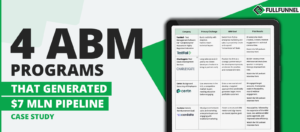According to Value Prime Solutions companies whose sales teams compete on value, not price, see an increase of 26 percent more sale reps attaining quota.
The value selling framework helps to make sure that sales reps are consistently managing dialogue to uncover what the buyer thinks is valuable and then uniquely connect what they’re selling to the vision of the buyer’s value in a problem set.
This is the biggest benefit of value-based selling, also known as the solution-based sales approach.
The truth is that almost every sales rep will say he is focusing on value when talking to the prospects and the leads, but then is struggling to attain the sales quota.
So today I invited Chad Sanderson, the Managing Partner at Value Prime Solutions and host of the popular podcast, called The B2B Revenue Executive Experience podcast to talk about how to accelerate sales and revenue with value-based selling.
Table of Contents
ToggleWhat is value selling?
Value-based selling is a process of defining the real needs, measurable objectives, possible impact on the potential customer’s bottom line, and pricing accordingly to the value our product can deliver.
What differentiates value selling is an impact-oriented approach.
Instead of the fixed price (e.g. Our rate is $50/hour) sales rep tries to evaluate possible annual earnings or savings his product can deliver. Then, based on the predicted outcomes he evaluates the project value including challenges that will be solved and objectives that will be met.
2 reasons why sales reps miss their quota
Before we dive into the value-based selling approach, let’s reveal the most common reasons why sales reps miss their quota.
The first one is they don’t have a consistent sales methodology.
Revenue executives tend to think they can hire A-players, guys that have knocked it out of the park, so they don’t need any sales methodology in place.
The second reason is heavy sales methodology.
By “heavy” I mean that the methodology doesn’t provide any value to the sales reps and only overcomplicates their work.
For example, if the sales rep doesn’t understand all the benefits of Salesforce, he will never leverage them. This is a very common challenge with using sales tools.
If we were using something like Salesforce which is an extremely powerful tool, but if we couldn’t show the rep why it is valuable for them, they wouldn’t use it.
So you’d always be constantly following salespeople around with questions such as ‘did you update your pipeline? Your forecasts?’, whatever.
How to arrange value-based discovery calls
First of all sales rep must be sure he is giving the price for the right stuff and then get into the conversation. So they should start the sales process with the value-based discovery call.
The sales rep should ask open questions to get the leads talking about:
- what is their KPI,
- what is their measurable objective,
- what problems are they getting in the way of attaining objectives
- what do they think the solution is?
These questions helps also to better understand the target audience and create an ideal customer profile.
The next step is to figure out the impact the possible solution will have on the lead’s organization.
One of the best questions sales rep can ask is:
— If we’re able to provide a solution that matches what you just said and solves the problems that you just outlined and that helps you achieve your KPI, what kind of impact will that have on your organization?
This way sales reps can figure out what is valuable for their leads: saving time or money, getting funding, scaling revenue, etc.
With this framework sales rep can formulate what he thinks is the best solution for the lead, argue why is this solution the best, demonstrate the exact impact this solution will have on the lead’s business and move the conversation from the “gimme that price” to the values.
If the buyer leads the conversation and just says:
“This is what I want, I need to know the price”, — and the sales rep just will give the price, you’ll never be able to demonstrate the values and the benefits of the product.
As a result, the deal value will be lower than possible.
How to deal with the situation when the leads don’t want to share the information
Even if both sides realize that the discovery calls based on the value selling framework help to figure out a better solution, sales reps often face the situation when the leads don’t want to answer the questions and share the information.
Some leads might think these questions are invasive.
The most common reason why this happens is that the leads don’t have enough time for the conversation, they have a short time horizon upon which to make a decision, or, the conversation isn’t valuable for them.
The best way to deal with this kind of lead is to reframe the conversation.
Here is an example of script sales reps can use:
— I understand. I just need to ask a couple of questions because I want to make sure I’m giving you the right answers and while I’ve done my research and I know you know these three things about your company, I need your perspective so I can make sure I am helping you and that we’re a good fit.
We had maybe that we’re not the right solution for you and I don’t want to waste your time, but if we can just cover a couple of these things really quickly, we’ll be able to determine that.
This way the sales rep can demonstrate he is really focused on the lead’s success, not just pushing the product.
The vast majority of sales reps never use this solution selling approach.
They entirely focus on their numbers and try to move fast. Sure, they should be focused on the results, but they can attain and beat them if they’ll slow down, prepare for the calls, ask open questions and be empathetic with the buyer.
At the end of the day, people buy from people. Nobody likes to talk to the Wolf from Wall Street or to Chris Varick from the Boiler Room, and feel they are manipulated.
How to influence the decision-making process when you don’t have direct access to the decision-maker
In the vast majority of cases sales reps usually start the sales conversation with the people who influence the decision but aren’t the decision-makers.
The conversation usually ends with the promise to present the solution to the CEO and provide feedback.
This is the stage where companies see the biggest reduction in their sales funnel.
My colleague describes this process as a black box with unpredictable results. Nobody has a clue what happens to the proposal, how it was presented or was it even presented, what did the CEO reply, etc.
What is the best way to influence the decision-making process?
The best way is to use the same value selling framework to figure out the challenges and KPI of the person who does the initial research and builds a relationship.
Sales reps still should you the same value-based discovery calls, but they also should ask who is the decision-maker, and what is his business issue and objectives.
This is very important because usually the boss just sets up a goal to accomplish a specific task in a specific timeframe with the specific results.
The next step is to understand the challenges that prevent achieving this business issue in-house and the view of the possible solutions.
The sales rep also should figure out the possible impact on the lead’s team and other bottlenecks the lead didn’t think about.
When the sales rep knows this information he can tie the lead’s personal goals with his company goals, and demonstrate the values of the product for both sides.
He can map out all the problems and bottlenecks the lead didn’t even think about, highlight the missing elements in the solution the lead’s team thought about and give the preliminary plan on how to exceed the lead’s company goals.
This way the sales rep helps the buyer to create a business case instead of a product proposal and, as a result, presents his company in a better way to the CEO.
In a nutshell, with this solution selling framework sales reps can armor their leads with concrete arguments to sell their solution internally.
Often, sales reps face the situation when they talk just to the person who is in charge of the initial research but isn’t involved in the decision-making process.
So during the value-based discovery calls, this person can’t really provide any insights into the business objectives, KPI, challenges, and solutions.
Usually, this person just asks for the case study, reference, or proposal.
In this case, Chad suggests applying a quid pro quo approach.
So if the person asks for something, a sales rep can also ask for another call with a person who is involved in the decision-making process and walk them through the case study and collect the necessary information for the qualification.
How to qualify prospects with value selling methodology
There is a common problem for companies when sales reps focus on hitting some numbers in the sales pipeline and waste time on leads who aren’t ready to buy.
Value-based selling helps to align both marketing and sales on these 5 criteria:
- what is the lead’s KPI,
- what is the lead’s measurable objective,
- what problems are the lead getting in the way of attaining objectives,
- what does the lead think the solution is,
- who is the decision-maker?
If you have any data for one of these points, the lead can’t be counted as sales-qualified.
When a sales rep has this information, he can easily see whether this lead is a good fit or should be disqualified.
How to increase average deal value with the value selling
The best way to increase the average deal value is to figure out additional challenges the lead even didn’t think about and demonstrate the tangible ROI.
It can be revenue growth, it can be time-saving, and it can be reduced costs.
Here is how sales reps can do this.
After the initial value-based qualification they should start asking probing questions about possible challenges that the lead didn’t mention.
For example, if the sales rep has a conversation with a CFO, he can ask questions like:
— Does your team have a problem with too much discounting? Is your team struggling right now to gain access to the CEO?
This way sales reps can have a more complete view of the problem set and add more options to the initial solution.
Then, they can demonstrate the initial solution and the added elements so the lead can confirm he needs to solve all these challenges.
The next step is to show a quantifiable return.
For example, the sales rep can articulate the $300.000 increase in revenue generated in the next six months and ask for $100.000.
This way sales rep doesn’t sell a product service, he sells the business results and charges accordingly to the generated value.
He eliminates discount questions as he has already demonstrated the value his solution can bring to the lead’s business.
As well, with the value selling approach, he solves the budget issue when the lead says at the early beginning they have a small budget.
Often, when they see the exact value, they can find the money even if they weren’t budgeted.




